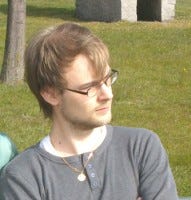
Featured Blog | This community-written post highlights the best of what the game industry has to offer. Read more like it on the Game Developer Blogs or learn how to Submit Your Own Blog Post
The Creative and the Leader
In this post I discuss the differences of creative and project leadership in smaller game development teams. It is the first part in a series of reflections from my time in the Make Something Unreal Live competition.

Reflections on Leadership – Part 1
This text is based on my experience from the Loch Ness project that later became Epigenesis, which won the Make Something Unreal Live 2013 competition hosted by Epic Games’ Inc. In this first part of a series of reflections I will discuss the difference between Creative and Project leadership, summing up with a discussion on why it is a bad idea to have both of these roles on the same person in a project with ten people. This text is meant for students/new leaders who are in the same situation I was in roughly six months ago. I have taken much inspiration and thoughts on leadership from Michael A. West’s excellent book Effective Teamwork, and while it isn’t focused on game development there are many wisdoms to be had from reading it.
Creative and Project Lead – What’s the difference?
What is the difference between the Creative and the Project Lead? This will most likely depend on your group structure and the specific needs of your group. For example, if you have a small group with only four to five members, it might be better to have these roles on the same person to free up the others for actual work on the game. But for now, let’s focus on their differences.
The Creative
The picture below describes very simply the relationship between the Creative Lead (C.L), the members of the team and the product that is to be produced (in this case, a game). The members represent all of the members in your group, including but not limited to artists, programmers and designers. They are all tasked with producing material for the product, and the Creative stands as a filter between their work and the finished game. His job is to make sure that everything that gets created will neatly fit together in the end, he will also make sure that the core of the game stays intact and doesn’t get messed with by any of the members. His job is to communicate the team’s vision to the rest of the members, to make sure that everyone is going in the same direction at all times.
The Creative and the Product
In my experience, the best way of doing this is to always try to make yourself available for your team. Work-related feedback is key here, try to take time out of your daily work to talk to every member of the group about their current work and how it can be improved to fit better in with the core of the game. There is of course a fine line between how much and how detailed your feedback should be, no one wants to be hassled every hour by someone who doesn’t like the color of the nails on their character. Your job is not to make everything look just the way you personally want it, but to make sure that everything that gets created fits with the vision for the game. Being a small team, you probably came up with the core of the game together, so there is a good chance that your personal opinion might not always be the one that gets the game in the right direction.
The Leader
On the picture below you can see the relationship between the Project Lead (P.L), the members, the Creative and the Product. While the Creative is the leader of the creative process, the Project Lead is the leader of the team itself (hereby referenced to as the “Leader”). Guiding the members in their daily work, the Leader is responsible for delivering the product on time and on schedule. It is the Leader that handles inter-team relationships such as with other game studios, publishers and other organizations. The Leader supports the team in order to ensure that the product gets made according to the vision, but he will always put time management, team budget and group members’ mental health first. In this matter, the Creative and the Leader have two different angles on the same problem. Both of them want to create a “good” product in the end, but while the Creative tries to hold the product close to the vision, the Leader will try to get the product done on schedule without any delays.

The role of the Project Lead
As a Leader, I made sure that my team had all of the resources and skills they needed to complete the task assigned to them. During this project, this included discussing with teachers at our school to give us more time to work on our project, but also making sure that my members had the social skills needed to work together as a team. The last one is in my mind one of the most important, interesting and rewarding topics in leadership and I will discuss it more thoroughly in a later part in this series. This leads me to the last part of the picture that describes the roles of Leader and Creative.
The group must be effective
The primary function of the Project Lead is to make sure that the group is effective in its day-to-day work. As you can see on the picture below, effectiveness involves not only the Leader but also the members of the group. One could make the case that the Creative also has a responsibility as a member to ensure group effectiveness but this is not his primary function.

The focus of the Leader.
Everything that the Leader does should in some way increase team effectiveness. You need a schedule so that members know what to work on, a budget so that your team doesn’t run out of money before they are finished with the project and personal coaching so that the members don’t suffer a mental breakdown from stress. All of these, and much more, is done to increase the effectiveness of the team.
There are a couple of different ways of leading a team, all suited to different circumstances. I use is what West calls a facilitative style with focus on transformation (West, 2004, p. 71). This style is best suited when the task is unclear and complex while having a highly skilled and motivated team. It focuses on consulting your members for advice on how to make decisions and using charisma to transform the members’ views of themselves and their work. As a Leader, you should focus on helping the members to make the decisions themselves, as long as it does not influence team effectiveness. When members asks what they should do or how to solve a problem, try to coach them into finding the solution themselves, using questions such as “How would you go about solving this problem?” and “What do you think the real problem is?”
Both roles on the same member, why not?
I am now going to make the case why it is a bad idea to have these two roles on the same member, these all comes from personal experience as I had both of these roles during the entire MSUL13 competition.
Arguments
When arguing about which feature to implement in the game, the two key words that are often considered are “time” and “priority”. While the Leader is responsible for delivering the product on time, the Creative is responsible for making sure that the features get prioritized correctly. This will most likely lead to arguments as the feature the creative sees as important might not always be the best choice time-wise. In these arguments, it is important to have the two sides represented by different persons so that an actual discussion can take place.
Decisions
This depends on the preferences of your group. I recommend that you let the Project Lead decide on a date when an important decision needs to be made, and if the team can’t come to an agreement by then the Creative has final say and must make a decision. This is derived from the focuses of the two roles. The Leader is focused on effectiveness, in order for him to be able to work toward this end he should have the right to force the team to make important decisions so that the team doesn’t reach a standstill. The Creative on the other hand should be focused on the vision, and is thusly most qualified to take a decision based on what he has heard from the discussions. This might not be the case under all circumstances, as a decision might impact budget or time schedule the Leader might have to step in and prevent the Creative from taking a decision that might otherwise drive the whole team off a cliff. Preferably the Creative should always consult the Leader for input on the effects of his decision before actually making it.
Time
Both of the roles are time consuming, and if one person has them both there is a good chance that he will focus his attention more on one of them and partly neglect the other. This might not be the case in smaller teams, i.e. three to five, but in larger teams such as six to ten members I strongly suggest giving the roles to two different members.
Coaching
As a Leader, you will have to coach your members to be more effective in their roles. While doing this, as mentioned before, you should try to ask open questions to help the member use his own creativity and abilities to fulfill his tasks. On the other hand, as a Creative, you sometimes have to step in to correct a member that is going off track from the vision. The line between creative freedom and creative restriction can sometimes be hard to make out if you are responsible for both.
Teams smaller than five
In a smaller team (three to five members) you might want to put both of the roles on the same person in spite of what I have previously discussed. This is because the roles will not be so time consuming that they are not manageable by one person, and if you split the roles between two people you will have two members that are not able to completely focus on their work on the game. Remember that what I have written here are only suggestions, and you should adjust the roles and the authority of the members that have them to work for you.
End of Part 1
In this post I have discussed two different kinds of leadership with focus on game development in smaller teams, I have tried to shed light on the differences and aspects of Creative and Project leadership from my point of view. I hope that my experiences have been of help to you, please stay tuned for Part 2 were I will focus on the role of the Project Lead, discussing how the Leader can increase team effectiveness and what tripwires there are for new Leaders.
Bibliography
West, M. A. 2004. Effective Teamwork: Practical lessons from organizational research. 2nd Ed. Leicester: The British Psychological Society, Oxford: Blackwell Publishing Ltd. ISBN: 978-1-4051-1058-7.
Read more about:
Featured BlogsAbout the Author(s)
You May Also Like







.jpeg?width=700&auto=webp&quality=80&disable=upscale)








